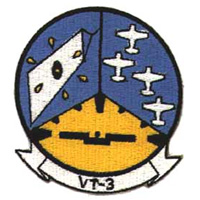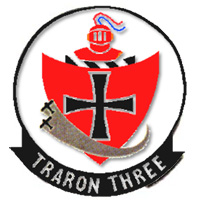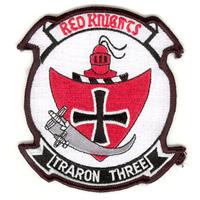 VT-3 Red Knights
// Training Air Wing Five
VT-3 Red Knights
// Training Air Wing Five
History
With World War II raging in both the Atlantic and Pacific Oceans and the demand for trained pilots at its peak, the first squadron to bear the name Training Squadron Three was created. On February 15, 1943, one week after the beginning of the massive air raids against Bougainville and Rabaul in the Solomon Islands, Training Squadron Three, Detachment 8-B (VN3D8-B) was organized under the command of LT Thomas Bradbury, USN at Saufley Field, Pensacola, Florida. VN3D8-B was relocated to Whiting Field, Milton, Florida on July 1, 1943 and was later joined by VN3D8-A from Chevalier Field to form Training Squadron Three. It is interesting to note that during the Second World War, Naval training squadrons were identified by the designator "VN" - this is because at the time, the "VT" designator was used to denote torpedo bomber squadrons. Throughout the costly struggle with axis forces, Training Squadron Three continued to train pilots to replace those lost in combat operations, as well as to man the units which would be needed for the final campaigns against the Japanese mainland. On September 2, 1945, following months of punishment by American forces, the Japanese military government signed the terms of surrender, and the struggle which claimed the lives of millions came to a sudden halt. VN-3 was decommissioned 18 months later in 1947 due to a reduced demand of military trained and war-ready pilots. VN-3 earned its place in annals of Naval History as a squadron which took great pride in preparing the cream of America's youth for the defense of this nation.
On May 1, 1960, a new generation of warriors picked up the torch lit by their predecessors and continued the legacy of "Training the Best for America's Defense." On that day Training Squadron Three (VT-3) was re-commissioned at South Whiting Field and tasked with preparing the younger generation to become world class Naval Aviators. They would utilize the T-28 Trojan to train student pilots in the art of Formation Flying, Radio Instruments, and Air-to-Air Gunnery. At the time of commissioning, a new patch insignia was designed and proudly worn by each squadron member. The new squadron patch was divided into three sections to represent each area of the squadron's primary training mission:

Although VT-3 had been re-established in the training scene for only a few years, they had already earned a reputation for high standards, and they proved it in April 1962 when the squadron organized a precision formation flight team dubbed the "Flying Diamonds." The team consisted of sixteen airplanes, piloted by the squadron's own formation flight instructors. They flew demonstrations for the next three years as a model for teamwork, knowledge, and safety. The "Flying Diamonds" appeared in several local air shows where they continuously affirmed their level of expertise to the local, as well as the military flying community. In 1965, the squadron revamped its training syllabus and Air-to-Air Gunnery was discontinued; Flight Familiarization and Basic Instrument Training were added in its place.
In 1968, at the height of the Vietnam War, VT-3 was at its peak in size and consisted of 174 instructor pilots, 494 student pilots, 649 enlisted members, and 162 T-28 aircraft. By the end of 1968, VT-3 had flown almost 110,000 instructional hours and trained 902 students in the basic prop-training course for that calendar year. These figures represent the record for any training squadron in the history of the Naval Air Training Command. With the Vietnam War winding down in the early 1970s, VT-3, like most other military commands, began to downsize.
VT-3 remained at South Whiting Field for thirteen years until 1973, when the squadron joined VT-2 at North Whiting Field to make room for the newly formed Helicopter Training Squadrons at South Field. The VT squadrons have remained in these spaces ever since. Even though VT-3 has not been relocated in over 50 years, it has remained steadfast in its mission, earned a host of accolades, and experienced a lot of significant changes.
In 1977, VT-3 was identified as the first primary training squadron to officially transition from the T-28 Trojan to the T-34C Turbomentor, thus ushering in a new era of Student Naval Aviators training completely in turbine engine aircraft. The 1980s again placed VT-3 on the historical timeline when it became the only primary fixed wing training squadron to be alternately commanded by a Navy and Marine Corps officer. Lt Col G.A. Brown was the first Marine Corps Commanding Officer from 1980-1981, and his tenure brought about a redesign of the squadron's patch. The old squadron emblem was changed to more accurately reflect the accomplishments, as well as the high standards set by the squadron:

The new insignia was an adaptation of the "Flying Circus" - the most feared and effective German squadron of the First World War. The Flying Circus was an innovative squadron which set the standard for combat techniques and tactics in the first era of aerial combat. The Red Knight represents the commander of the Flying Circus, Baron Manfred Von Rickthofen, known affectionately to the world as the "Red Baron." The two aircraft represent formation training conducted at VT-3 and the need for discipline and vigilance in the air. VT-3 embraced its identity, and over the course of time became known as the "Red Knights of Training Squadron Three."
Known well through history to lead the way as pioneers in Naval Aviation training, the "Red Knights" were honored yet again in 1994 when they became the Navy's first and only Joint Service Primary Flight Training Squadron. The first Air Force instructors reported in February 1994; the first Air Force students followed in July of that same year; and the first Air Force Commanding Officer, Lt Col Shawn Elliott, took Command of the squadron from 1995-1996. The transition to a joint flight training program was also accompanied by an update to the squadron patch, which is the design currently worn by instructor pilots and student aviators:

The 21st century brought yet another phase in evolution where the U.S. Navy found a need to bridge the technological gap between its training aircraft, and its sophisticated fleet aircraft. Being no stranger to innovation, VT-3 was tasked as the first Navy training squadron to fly the new Joint Primary Pilot Training aircraft, the T-6B Texan II. The T-6B is faster, stronger, and more efficient than the T-34C, and is designed specifically to position students for success in modern aerial platforms. Today, the "Red Knights" continue to provide the highest quality training to student aviators from the Navy, Marine Corps, Coast Guard, and several allied nations. Each student is instructed in Day and Night Familiarization, Precision Aerobatics, Basic Instruments, Radio Instruments, and Primary Formation. Upon completion of their training, Navy, Marine Corps, and Coast Guard students are tracked for further training in Rotary Wing Aircraft, Maritime, Strike, or Command and Control Communities.
Each of the 60 flight instructors, 1 enlisted, and 12 civilian personnel assigned to VT-3 take great pride in being an integral part of training Student Aviators. Their combined effort is responsible for approximately 20,000 annual flight hours and the successful completion of over 225 primary students per year.





